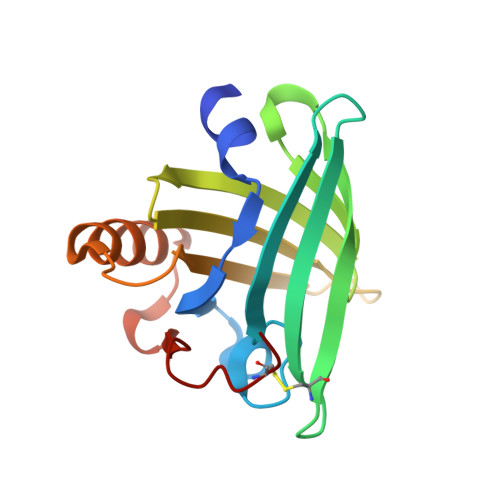Structural aspects of dog allergies: The crystal structure of a dog dander allergen Can f 4.
Niemi, M.H., Rytkonen-Nissinen, M., Janis, J., Virtanen, T., Rouvinen, J.(2014) Mol Immunol 61: 7-15
- PubMed: 24859823
- DOI: https://doi.org/10.1016/j.molimm.2014.04.003
- Primary Citation of Related Structures:
4ODD - PubMed Abstract:
Four out of six officially recognized dog allergens are members of the lipocalin protein family. So far, a three-dimensional structure has been determined for only one dog allergen, Can f 2, which is a lipocalin protein. We present here the crystal structure of a second lipocalin allergen from dog, a variant of Can f 4. Moreover, we have compared and analyzed the structures of these two weakly homologous (amino acid identity 21%) dog allergens. The size and the amino acid composition of the ligand-binding pocket indicate that Can f 4 is capable of binding only relatively small hydrophobic molecules which are different from those that Can f 2 is able to bind. The crystal structure of Can f 4 contained both monomeric and dimeric forms of the allergen, suggesting that Can f 4 is able to form transient (weak) dimers. The existence of transient dimers in solution was confirmed by use of native mass spectrometry. The dimeric structure of Can f 4 is formed when the ends of four β-strands are packed against the same strands from the second monomer. The residues in the interface are mainly hydrophobic and the formation of the dimer is similar to the major horse allergen Equ c 1. Interestingly, the crystal structure of dog Can f 2 has been reported to show a different type of dimer formation. The capability of these allergens to form dimers may be important for the development of immediate allergic reaction (mast cell activation) because oligomeric allergens can effectively present multivalent epitopes.
Organizational Affiliation:
Department of Chemistry and Biocenter Kuopio, University of Eastern Finland, PO Box 111, 80101 Joensuu, Finland.














